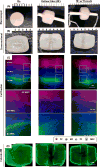Enhanced nutrient transport improves the depth-dependent properties of tri-layered engineered cartilage constructs with zonal co-culture of chondrocytes and MSCs
- PMID: 28629894
- PMCID: PMC5559709
- DOI: 10.1016/j.actbio.2017.06.025
Enhanced nutrient transport improves the depth-dependent properties of tri-layered engineered cartilage constructs with zonal co-culture of chondrocytes and MSCs
Abstract
Biomimetic design in cartilage tissue engineering is a challenge given the complexity of the native tissue. While numerous studies have generated constructs with near-native bulk properties, recapitulating the depth-dependent features of native tissue remains a challenge. Furthermore, limitations in nutrient transport and matrix accumulation in engineered constructs hinders maturation within the central core of large constructs. To overcome these limitations, we fabricated tri-layered constructs that recapitulate the depth-dependent cellular organization and functional properties of native tissue using zonally derived chondrocytes co-cultured with MSCs. We also introduced porous hollow fibers (HFs) and HFs/cotton threads to enhance nutrient transport. Our results showed that tri-layered constructs with depth-dependent organization and properties could be fabricated. The addition of HFs or HFs/threads improved matrix accumulation in the central core region. With HF/threads, the local modulus in the deep region of tri-layered constructs nearly matched that of native tissue, though the properties in the central regions remained lower. These constructs reproduced the zonal organization and depth-dependent properties of native tissue, and demonstrate that a layer-by-layer fabrication scheme holds promise for the biomimetic repair of focal cartilage defects.
Statement of significance: Articular cartilage is a highly organized tissue driven by zonal heterogeneity of cells, extracellular matrix proteins and fibril orientations, resulting in depth-dependent mechanical properties. Therefore, the recapitulation of the functional properties of native cartilage in a tissue engineered construct requires such a biomimetic design of the morphological organization, and this has remained a challenge in cartilage tissue engineering. This study demonstrates that a layer-by-layer fabrication scheme, including co-cultures of zone-specific articular CHs and MSCs, can reproduce the depth-dependent characteristics and mechanical properties of native cartilage while minimizing the need for large numbers of chondrocytes. In addition, introduction of a porous hollow fiber (combined with a cotton thread) enhanced nutrient transport and depth-dependent properties of the tri-layered construct. Such a tri-layered construct may provide critical advantages for focal cartilage repair. These constructs hold promise for restoring native tissue structure and function, and may be beneficial in terms of zone-to-zone integration with adjacent host tissue and providing more appropriate strain transfer after implantation.
Keywords: Cartilage tissue engineering; Co-culture; Depth-dependent properties; Hyaluronic acid; Mesenchymal stem cells; Nutrient transport; Zonal chondrocytes.
Copyright © 2017 Acta Materialia Inc. Published by Elsevier Ltd. All rights reserved.
Figures







Similar articles
-
Micrometer scale guidance of mesenchymal stem cells to form structurally oriented large-scale tissue engineered cartilage.Acta Biomater. 2017 Sep 15;60:210-219. doi: 10.1016/j.actbio.2017.07.016. Epub 2017 Jul 11. Acta Biomater. 2017. PMID: 28709984 Free PMC article.
-
Spatially patterned microribbon-based hydrogels induce zonally-organized cartilage regeneration by stem cells in 3D.Acta Biomater. 2020 Jan 1;101:196-205. doi: 10.1016/j.actbio.2019.10.025. Epub 2019 Oct 19. Acta Biomater. 2020. PMID: 31634627
-
* Constrained Cage Culture Improves Engineered Cartilage Functional Properties by Enhancing Collagen Network Stability.Tissue Eng Part A. 2017 Aug;23(15-16):847-858. doi: 10.1089/ten.TEA.2016.0467. Epub 2017 Mar 27. Tissue Eng Part A. 2017. PMID: 28193145 Free PMC article.
-
Challenges in Fabrication of Tissue-Engineered Cartilage with Correct Cellular Colonization and Extracellular Matrix Assembly.Int J Mol Sci. 2018 Sep 11;19(9):2700. doi: 10.3390/ijms19092700. Int J Mol Sci. 2018. PMID: 30208585 Free PMC article. Review.
-
Perspective in Achieving Stratified Articular Cartilage Repair Using Zonal Chondrocytes.Tissue Eng Part B Rev. 2023 Jun;29(3):310-330. doi: 10.1089/ten.TEB.2022.0142. Epub 2023 Jan 24. Tissue Eng Part B Rev. 2023. PMID: 36416231 Review.
Cited by
-
Extracellular vesicles mediate improved functional outcomes in engineered cartilage produced from MSC/chondrocyte cocultures.Proc Natl Acad Sci U S A. 2019 Jan 29;116(5):1569-1578. doi: 10.1073/pnas.1815447116. Epub 2019 Jan 15. Proc Natl Acad Sci U S A. 2019. PMID: 30647113 Free PMC article.
-
Physiology and Engineering of the Graded Interfaces of Musculoskeletal Junctions.Annu Rev Biomed Eng. 2018 Jun 4;20:403-429. doi: 10.1146/annurev-bioeng-062117-121113. Epub 2018 Apr 11. Annu Rev Biomed Eng. 2018. PMID: 29641907 Free PMC article. Review.
-
Cell migration: implications for repair and regeneration in joint disease.Nat Rev Rheumatol. 2019 Mar;15(3):167-179. doi: 10.1038/s41584-018-0151-0. Nat Rev Rheumatol. 2019. PMID: 30617265 Free PMC article. Review.
-
A composite scaffold of Wharton's jelly and chondroitin sulphate loaded with human umbilical cord mesenchymal stem cells repairs articular cartilage defects in rat knee.J Mater Sci Mater Med. 2021 Mar 29;32(4):36. doi: 10.1007/s10856-021-06506-w. J Mater Sci Mater Med. 2021. PMID: 33779853 Free PMC article.
-
In Vitro Maturation and In Vivo Integration and Function of an Engineered Cell-Seeded Disc-like Angle Ply Structure (DAPS) for Total Disc Arthroplasty.Sci Rep. 2017 Nov 17;7(1):15765. doi: 10.1038/s41598-017-15887-4. Sci Rep. 2017. PMID: 29150639 Free PMC article.
References
-
- He B, Wu JP, Chen HH, Kirk TB, Xu J. Elastin fibers display a versatile microfibril network in articular cartilage depending on the mechanical microenvironments. J Orthop Res. 2013;31(9):1345–53. - PubMed
-
- Mow VC, Wang CC, Hung CT. The extracellular matrix, interstitial fluid and ions as a mechanical signal transducer in articular cartilage. Osteoarthritis Cartilage. 1999;7(1):41–58. - PubMed
-
- Poole AR, Kojima T, Yasuda T, Mwale F, Kobayashi M, Laverty S. Composition and structure of articular cartilage: a template for tissue repair. Clin Orthop Relat Res. 2001;(391 Suppl):S26–33. - PubMed
MeSH terms
Grants and funding
LinkOut - more resources
Full Text Sources
Other Literature Sources
Research Materials
Miscellaneous

